
classification of animals, binomial nomenclature, animal classification, what is cloning, taxon, what is a cell, classification of flora , biological classification 11 notes, class 11 biology notes, biological classification class 11, biological classification class 11 notes, class 11 biological classification, note biology, biology notes, biological classification, class 11 cbiology chapter 2 notes, 11th standard biology notes, 11th std biology notes, class 11 biology notes chapter 2, biological classification chapter class 11 notes
1. |
Thallus | : | Plant body without true stem, root & Leaf. |
2. |
Plankton | : | Organism living in salty areas. |
3. |
Halophiles | : | Plants floating passively in water current. |
4. |
Chemosynthetic | : | Using chemical reactions as energy source |
5. |
Heterotrophic | : | Unable to synthesise own food and dependent on others for food. |
6. |
Pathogenic | : | Main body of slime mould. |
7. |
Plasmodium | : | Organism feeding on dead & decaying organic matter. |
8. |
Saprophyte | : | Organism which depend on living host for food |
9. |
Parasite | : | Two organisms living together |
10. |
Symbionts | : | benifitting each other. |
11. |
Plasmogamy | : | Fusion of cytoplasm. |
1. |
Karyogamy | : | Fusion of nuclei. |
2. |
Dikaryon | : | A cell with two nuclei. |
3. |
Dikaryophase | : | Stage of fungus with dikaryotic cells. |
4. |
Isogamous | : | : Morphologically identical gametes |
5. |
Anisogamous | : | Morphologically non identical Gametes. |
6. |
Oogamous | : | Female gamete oosphere and Male gamete motile. |
1.Aristotle classified organisms for the first time.
2. Two kingdom system includes – Plantae &Animalia.
1. No difference in Eukaryotes and Prokaryotes.
2.Heterotrophic Fungi kept in Plantae.
3. Five kingdom system is given by R.H Whittaker (1969) viz. Monera, Protista, Fungi, Plantae and Animalia.
1. Prokaryotic unicellular organisms.
2. Most abundant.
3. Also live in extreme habitats viz. Hotsprings, Snow etc. as endoparasite etc.
4.
eg. Bacteria.
- Some bacteria are autotrophic others are heterotrophic.
- Cellwall different from other bacteria.
- Live in most harsh habitats eg. Halophile.
- Methanogens are found in the gut of ruminants and produce methane (CH4) gas.
Eubacteria –
- True bacteria.
- Rigid cellwall with or without flagellum.
- Cyanobacteria( Blue green algae) are also included in this group.
- Cyanobacteria are Photosynthetic autotrophs, unicellular, colonial or filamentous, with gelatinous sheath.
- Have Heterocyst for N2fixation eg. Nostoc, Anabaena, Oscillatoria, Rivularia, Gloeotrichia etc.
- Mostly bacteria are Heterotrophs and are useful and harmful both to humans.
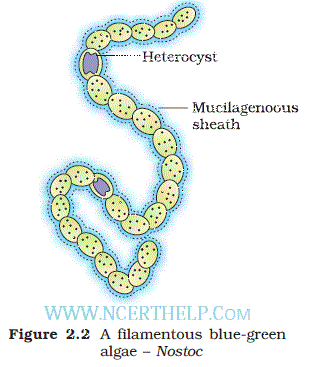
-Reproduction occurs by fission. Also by primitive type of sexual reproduction, by transferring DNA piece from one bacterial cell(+ strain) to other (- strain) (called cell Transduction).
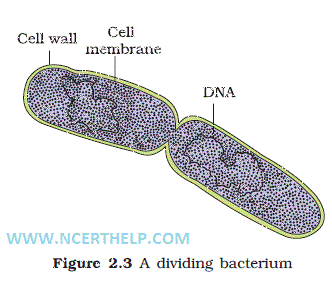
- Smallest unicellular anaerobic organisms having no cellwall.
- Pathogenic in plants and animals.
- Unicellular eukaryotes.
- Primarily aquatic.
- Some have cilia and flagella.
- Reproduction sexual and asexual both.
- Fresh water or marine microscopic Planktons.
- Mostly photosynthetic and cheif producer in ocean eg. Diatomsand Golden algae (Desmids).
- Diatoms with cellwalls in two halves having Silica (indistructible).
- Diatomaceous earth is formed by cellwall deposits of Diatoms and used in polishing, filtration of oils and syrups, fire bricks and explosives.
Dinofagellates –
- Marine.
- Photosynthetic yellow , green, blue, brown or red in colour.
- One longitudinal and other transverse two flagella.
- Gonyaulax causes Red tides.
- Fresh water forms.
- No cellwall, outer most layer pellicle.
- Two unequal flagella.
- Photosynthetic but also heterotrophic in absence of light ( Mixotroph).
eg. Euglena.
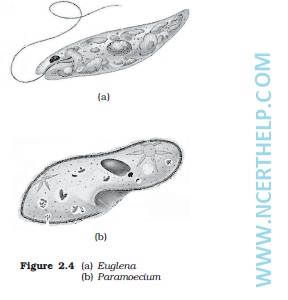
- Saprophytes.
- Body is an aggregation called „Plasmodium‟ ( multinucleate, without cellwall, irregular in shape and can spreadover several feet ).
- Plasmodium produces fruiting body having spores with walls which are highly resistant and spread through wind.
- Fresh water or marine unicellular heterotrophs.
- Primitive relative of animals.strong
(a) Amoeboid Protozoans –
- Free living or parasites.
- Pseudopodia (false feet) formed eg. Amoeba ,Entamoeba.
- Free living or Parasitic with flagella eg.Trypanosoma( causessleeping sickness).
1. Ciliated Protozoans –
- With cilia eg. Paramecium(sleeper animalcule).
(d) Sporozoans –
- Spore like stage in life eg. Plasmodium vivax.
Kingdom Fungi –
- Fungi are a group of achlorophyllous, heterotrophic organisms with cell wall without cellulose.
- Saprophyte or Parasite or Symbiotic.
- Useful and Harmful both.
- Prefer to grow in warm and humid places.
- Unicellular (eg. Yeast) to multicellular filamentous body called mycelium.
- One unit of mycelium called hypha .
- Mycelia maybe coenocytic (no septum) or septate.
- Lichens :– Symbiotic association of fungus and algae.
- Mycorrhiza ;– Symbiotic association of fungi with root of higher plants eg. Pinus.
- Reproduction :–Vegetative : by fragmentation and by spores.Sexual: by gametes.
- Three steps in sexual reproduction
1. Plasmogamy :– fusion of protoplasm.
2 .Karyogamy :- fusion of nuclei.
3. Meiosis of zygote.
- Grow on aquatic places or decaying wood or damp places or obligate parasite.
- Mycelium aseptate, coenocytic.- Reproduction - asexual by zoospores or aplanospores. Sexual by zygospores.
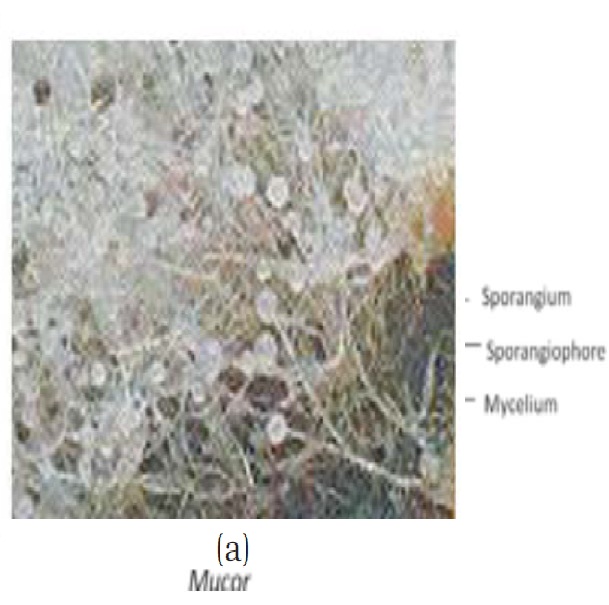
-Unicellular (eg. Yeast) or multicellular
-Saprophytic or parasitic.
-Maybe coprophillus (growing on dung) eg. peziza.
-Mycelium septate and branched.
-Reproduction – asexual by exogenously produced conidia.
-sexually by Ascospares produced in asci present in fruiting body called Ascocarp.
-egAspergillus, Claviceps, Neurospora, Saccharomyces (yeast) etc.
.jpg)
Basidiomycetes (club fungi) –
- Grow on soil , logs or parasites ( rusts and smuts).
- Mycelium septate and branched and of two types
- Uninucleate 2) Dikaryophase.
- Reproduction – vegetative by fragmentation sexualby two somatic cells giving rise to Dikaryophase.
- Dikaryophase makes fruiting body Basidiocarp having Basidia.
- Inside basidia (singular basidium)
- Karyogamy and meiosis occours.
- Meiosis results in formation of four basidiopores.
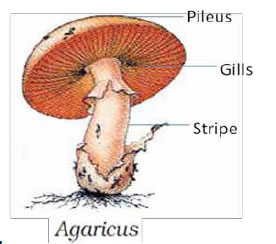
eg. Agaricus (mushroom), Ustilago (smut fungi), Puccinia (rust fungus).
- It is formed class – Group of Fungi whose complete life cycle is not known.-Saprophyte/parasite , mostly decomposers.- eg. Alternaria, colletotrichum, Trichoderma.
- Eukaryotic, chlorophyll bearing autotrophic organisms.
- Only few members partialheterotrophs eg. Insectivorus plants (Bladder wort and Venus flytrap).
- Few parasites eg. Cuscuta
- Reproduction – vegetative,asexual and sexual.
- Life cycle shows alternation of generation.
- eg. Algae, Bryophytes,Pteridophyte, Gymnosperms and Angiosperms.
Kingdom Animalia –
- Eukaryotic, Heterotrophic organisms.
- No chloroplast and no cell wall.
-Holozoic mode of nutrition
- Definite shape and size and capable of locomotion.
- sexual in general
- eg. frog, cockroach, cow, man etc.
- Viruses, Viroids and Lichens
- Viruses Connecting link between living and non living.
- Non cellular structure consisting of protein coat and Nucleic acid
- Can reproduce within a host cell.
- Host cell may be killed.
- Viruses which infect bacteria are called Bacteriophage.
- Tobacco Mosaic Virus (TMV)-
- Protein coat: - capsid consists of capsomers.
- Viruses can cause diseases viz. Mumps, Small pox, Herpes, Influenza, AIDS etc.
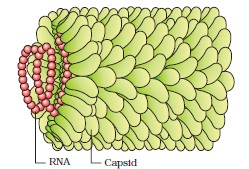
![]()
- Free RNA without protein coat.
Lichens- Composite organisms.
-Symbiotic association between Algae (Phycobiont),Fungi (Mycobiont).
Copyright @ ncerthelp.com A free educational website for CBSE, ICSE and UP board.